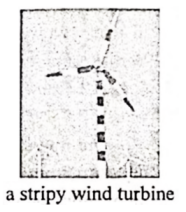
The number of seabirds killed by colliding(撞击) with wind turbines could be cut by painting black-and-white stripes on the blades(叶片), and poles, say researchers. Graham Martin at the University. of Birmingham, UK, and Alex Banks at Natural England, a public organization that has a say in planning applications for offshore wind farms in England, wanted to design a pattern that could be easily painted onto turbines to reduce their impact on bird life.
Between 140, 000 and 328, 000 birds are killed each year by onshore wind turbines in the US, according to, one estimate. It is harder to tell how many birds are killed by offshore turbines each year, says Martin, as they fall into the ocean,
A previous study, published in 2020, looked at the effect of painting a single blade black on four onshore turbines in Norway. Bird collisions were reduced by 70 percent compared with all-white turbines nearby. Martin believes that further improvements could have an even greater impact. Based on analysis of previous studies into bird vision and bird collisions with wind turbines, the two researchers came up with a series of guiding principles to aid their design of a turbine that would harm. fewer birds.
"Most birds do not see too much fine detail in their vision - especially compared to humans, " says Martin, so any design shouldn't be too complex. Many collisions occur in low light, so the design should be easy to decipher in the dark, while high internal contrast would help the turbine stand out against different backgrounds, such as a cloudy or sunny sky. In low levels of light, black-and-white patterns are best, says Martin. "In the dark, a red-and-white pattern would rapidly look like shades of grey, " he says. The design hasn't yet been tested, but Martin hopes that manufacturers will consider it, particularly as it would be easy and cheap to implement.